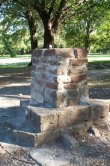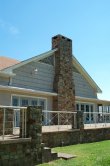|
This article, which is taken from Steven Butler's From Water Supply to Urban Oasis: A History of White Rock Lake Park (Richardson, Texas: Poor Scholar Publications, 2004), has also been published in D. Stanley Eitzen and George H. Sage's Solutions to Social Problems, From the Top Down: The Role of Government (Boston: Pearson Education, Inc., 2007).
- President Franklin D. Roosevelt, 1933 Message to Congress While the City of Dallas can be credited with the initial development of White Rock Lake Park, the federal government also left its mark. From 1935 to 1942, several permanent park improvements were made by the Civilian Conservation Corps (CCC), which performed the lion's share of the work, or were funded by the Works Progress Administration (WPA), two of the more visible and noteworthy federal agencies created by Congress as part of Democratic President Franklin D. Roosevelt's plan to combat the Great Depression. The CCC, which is almost universally held to have been a success, was formed in April 1933, shortly after Roosevelt took office. Authorized by Congress and created by Executive Order, the agency lasted until shortly after the United States entered World War II. Its goal was to provide unemployed young men between the ages of 18 and 25 with both work and the opportunity to learn a useful trade. (The Civilian Conservation Corps Act of June 28, 1937, which formally established the agency, later stipulated that "enrollees…shall be unmarried male citizens between the ages of 17 and 23.") Veterans on relief "with dependents to whom they are willing to make allotments from their salary" were also eligible for the program. Jointly administered by the National Park Service and the United States Army, the CCC established camps all over the United States where youthful recruits labored at a wide variety of public works projects. They were paid $30 per month, $25 of which was sent home to their families. In addition to providing the youths with jobs, the agency also hoped to educate the men and provide them with an opportunity to learn a useful trade. DALLAS GETS A CCC CAMP
On Wednesday, August 14, 1935, one hundred and twenty recruits from Collin County arrived at the White Rock Camp to form CCC Company 2896. The following day, sixty-nine young men from Dallas County joined them. These were the first of approximately 3,000 youths who, over the course of the next seven years, would spend from six months to two years learning a trade and performing a valuable public service at the same time. Among the early arrivals were "three Negroes" for whom it was reported that Commander England was awaiting "orders regarding where they should be sent." These orders were necessitated due to the fact that like the U.S. Army at that time, CCC companies were not racially integrated. What became of these three young men is unknown. In all likelihood, they soon joined an all-black company in some other part of the country.
During the first two weeks of their six-month enlistment, reported the Dallas Morning News, this first wave of recruits performed some "necessary work around the camp" and were given "medical and dental treatment" prior to embarking on a "two year park improvement program" that would include "deepening and widening the lake," as well as "clearing underbrush, building bridle paths, trails, picnic grounds, barbecue pits and shelter houses and terracing work." After only two weeks on the job. Lieutenant Sandison, England's second-in-command, was transferred to Gatesville, Texas. He was not immediately replaced. In early 1936, First Lieutenant George P. Parker of the 53rd Field Artillery succeeded Lieutenant England as camp commander and Captain Deatherage, the camp's doctor, was also replaced. His successor was Captain A. H. Atlas of the 328th Medical Regiment. Later that year, Second Lieutenant A. S. Jones of the 53rd Field Artillery was appointed second-in-command to Lieutenant Parker.
At the bottom of the hill, at the corner of Northwest Highway, Goforth Road, and a newly-built ring road called Doran Circle, the CCC enrollees constructed a cluster of limestone buildings, the largest of which was originally used as a concession stand where park-goers could purchase fish bait, picnic supplies, cold drinks, and similar commodities. A garage and a latrine completed the complex. Today this collection of CCC-built structures forms the East Region headquarters of the Dallas Park and Recreation Department.
When it was built the Sunset Bay concession building featured a dark walnut wooden sign complete with cast iron hardware forged in the CCC camp's blacksmith shop. The sign, which was decorated with carved oak leaves and colorfully embellished 3 inch carved letters, read: "Sun Set Inn, Dinner, Drinks, [and] Sandwiches." A smaller wooden placard, which hung below, advertised the availability of bicycles for rent. This sign has long since disappeared. Similar signs were erected at the Doran's Point concession complex and the Big Thicket concession building. The CCC blacksmith shop was also used, no doubt, to create the whimsical cast iron frogs, birds, fish and other creatures that decorate the windows of a stone latrine built by the CCC, which still stands near the Dixon Branch or "Stone Tables" picnic area. M. A. Burke designed them. A small bridge and spring-fed lily pond, designed by another local man, N. S. McCommas, were also constructed nearby during this same period. All have since fallen into disrepair.
By chance, the presence of the CCC camp at White Rock coincided with the 1936 Texas Centennial Exposition, which was held at nearby Fair Park. There, throughout the term of the six-month event more than 2,000 "man-days" were expended enlightening exposition visitors about the role of the CCC in combating the Great Depression and in all probability, highlighting the agency's contribution to the improvement of White Rock Park. A one-story stone building, constructed by the CCC, housed the exhibit, which included a tabletop model of a typical CCC camp. At the conclusion of the its first two years of operation, a report was prepared (probably by Lieutenant Parker) summarizing the White Rock camp's initial accomplishments. In addition to the buildings constructed at Doran's Point, Dixon Branch, and Sunset Bay, the young workers transplanted 1,500 trees to the Doran's Point area, constructed 6,000 feet of "rip-rap" retaining walls at various points around the lake, completed several erosion control projects, and planted 75 acres of pecan seedlings in what is now Norbuck Park, which they took special care to protect from grass fires. Today's park visitors probably take these and other trees planted by the CCC for granted but aerial photos taken prior to 1930 reveal that trees were not as abundant before the arrival of "Roosevelt's Tree Army." Only in the Dixon Branch area and along some of the other creeks that feed the lake was there any sizeable foliage prior to the establishment of the park. Between 1935 and 1937, the CCC also placed "thirty-five hundred bundles of willows and one hundred yards of gravel…in the lake." "The willow bundles," explained CCC officials, were "for the protection of small fish and the gravel beds for spawning beds." For the benefit of park visitors, approximately 90 "table and bench combinations" were "constructed and placed in extensively used picnic areas, adjacent to the eastern shore of the lake" along with "70 camp stoves and fireplaces." The 1937 report concluded with a list of "Proposed Developments." Foremost among them was a plan to use a dredge boat to reclaim the shallow marshlands that had formed at the mouth of Dixon's Branch, owing to the deposit of silt over a period of time. When spanning fish were trapped here during periods of drought, read the report, "rapid evaporation and [the] hot sun soon kill them, resulting in the loss of the fish and causing offensive odors plus unsanitary conditions." CCC HELPS WITH FIRST DREDGING At first, no one was sure whom to blame for the accident and "rumors began flying that the CCC workers were drunk much of the time." Eventually, these accusations proved to be unfounded. After W. J. Redman, a professional diver from Galveston, re-floated the Lawther, it was discovered that manufacturing defects, including a lack of "hard timbers to overcome vibration of the engines", caused four leaks in the boat's hull. During the winter of 1937-1938 the Joe E. Lawther was repaired. Dredging resumed in April 1938 and continued until February 1939. Together with some further dredging that was performed intermittently until the beginning of World War II, nearly 90 acres of land was eventually reclaimed; 68 acres at the northern end of the lake and 20 at Dixon's Branch. The removed silt was used to fill marshy areas around the lake or sold for 25 cents per cubic yard to anyone who had the means to take it away. Bachman Lake, a smaller park located on the northwestern edge of the city, also received attention from the "boys in green" at White Rock. One of most enduring improvements they made was a shelter house or picnic pavilion that was fashioned out of stone and heavy timbers. It is still standing on the Northwest Highway side of the reservoir. Recruits also built a latrine, planted trees and shrubs, and constructed numerous picnic table and bench combinations to complement the many fireplaces they also put in place for the convenience of picnickers. Entrance portals, probably similar to the one they built on East Lawther Drive at White Rock, were proposed but never built. COMPANY 2896'S LAST PROJECT NEW USES FOR THE CCC CAMP CCC LEGACY |
c. 1936 Roster of Extant CCC Projects at White Rock Lake Park
|
Photos used in page banner courtesy the Library of Congress, Washington, D.C.
CCC Camp photos courtesy The White Rocker.
This website copyright © 1996-2017 by Steven Butler, Ph.D. All rights reserved.



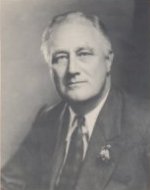 FDR AND THE
CCC
FDR AND THE
CCC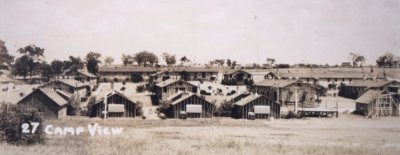 The White Rock CCC camp consisted of several wooden structures painted yellow. These included barracks, a mess hall and canteen, a dispensary, and several small sheds or outbuildings. Arranged around an open "service yard" were an office, a combination blacksmith shop and storage building, a ten-car garage, and a combination woodworking, repair shop, and storage facility. A road, roughly following the same route as present-day Emerald Isle Drive, led to the camp from State Highway 78 (present-day Garland Road) and encircled it. Another short road connected the camp with East Lawther Drive.
The White Rock CCC camp consisted of several wooden structures painted yellow. These included barracks, a mess hall and canteen, a dispensary, and several small sheds or outbuildings. Arranged around an open "service yard" were an office, a combination blacksmith shop and storage building, a ten-car garage, and a combination woodworking, repair shop, and storage facility. A road, roughly following the same route as present-day Emerald Isle Drive, led to the camp from State Highway 78 (present-day Garland Road) and encircled it. Another short road connected the camp with East Lawther Drive.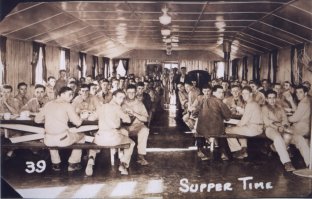 The average age of a recruit at the Dallas camp was 20. Although some were city boys, the majority came from rural areas in Dallas and surrounding counties, principally Collin, Denton, and Tarrant. They aspired, according to one report, "to be modern farmers, mechanical engineers, or Civil Service employees." Several were "attending night school in order to complete their education and training in an endeavor to realize their various aspirations."
The average age of a recruit at the Dallas camp was 20. Although some were city boys, the majority came from rural areas in Dallas and surrounding counties, principally Collin, Denton, and Tarrant. They aspired, according to one report, "to be modern farmers, mechanical engineers, or Civil Service employees." Several were "attending night school in order to complete their education and training in an endeavor to realize their various aspirations."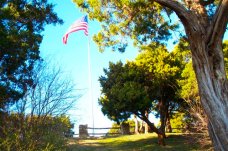 The first area to receive the company's closest attention was Doran's Point, now called "Flag Pole Hill." The appearance of Doran's Point, "a barren rock hill" overlooking the northern end of the lake, was almost completely transformed between 1936 and 1937. The work included and probably started with the obliteration of a dirt road that previously led to the apex of the mound on its east side. After leveling off the top of this natural vantage point, the youthful workers formed $283 worth of logs, cement and 40 tons of flagstone into a picturesque overlook surmounted by a tall flagpole and accessible by sixteen wide stone steps from a newly-paved parking area. Some local craftsmen assisted them. On the top of an adjacent, more gently rising sloe, they constructed an 81-foot long open-air picnic shelter made of Cordova limestone, a small stone latrine, and an all-purpose stone building that was afterward used for many years to house transmitting equipment for city-owned radio station WRR. All these structures are still standing, although the former radio transmitting building is today a designated "athletic building." The transmission towers that stood nearby it are gone, however.
The first area to receive the company's closest attention was Doran's Point, now called "Flag Pole Hill." The appearance of Doran's Point, "a barren rock hill" overlooking the northern end of the lake, was almost completely transformed between 1936 and 1937. The work included and probably started with the obliteration of a dirt road that previously led to the apex of the mound on its east side. After leveling off the top of this natural vantage point, the youthful workers formed $283 worth of logs, cement and 40 tons of flagstone into a picturesque overlook surmounted by a tall flagpole and accessible by sixteen wide stone steps from a newly-paved parking area. Some local craftsmen assisted them. On the top of an adjacent, more gently rising sloe, they constructed an 81-foot long open-air picnic shelter made of Cordova limestone, a small stone latrine, and an all-purpose stone building that was afterward used for many years to house transmitting equipment for city-owned radio station WRR. All these structures are still standing, although the former radio transmitting building is today a designated "athletic building." The transmission towers that stood nearby it are gone, however.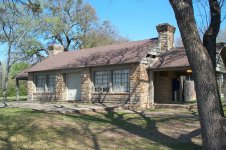 During this same period of time, utilizing plans drawn up by local architect named M. A. Burke, the young men of the CCC began constructing a limestone and wood concession building on a slightly elevated tract of land overlooking Sunset Bay, at the mouth of Dixon's Branch creek. Both this building and the park caretaker's cottage, constructed immediately behind it, are still standing today, along with a T-head fishing pier that continues to attract anglers, duck feeders, and people curious to see the large flock of pelicans that often spend the winter in this location. As its name implies, Sunset Bay is also a popular place to view the sun setting over the distant skyscrapers of downtown Dallas. In 2004, a statue honoring the White Rock CCC enrollees was erected here.
During this same period of time, utilizing plans drawn up by local architect named M. A. Burke, the young men of the CCC began constructing a limestone and wood concession building on a slightly elevated tract of land overlooking Sunset Bay, at the mouth of Dixon's Branch creek. Both this building and the park caretaker's cottage, constructed immediately behind it, are still standing today, along with a T-head fishing pier that continues to attract anglers, duck feeders, and people curious to see the large flock of pelicans that often spend the winter in this location. As its name implies, Sunset Bay is also a popular place to view the sun setting over the distant skyscrapers of downtown Dallas. In 2004, a statue honoring the White Rock CCC enrollees was erected here.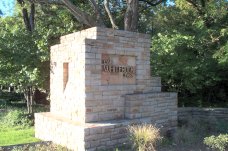 Another noteworthy CCC project designed by M. A. Burke is the park's entrance portal, constructed at the junction of East Lawther Drive and Garland Road. It incorporates a stone bridge in its design. Cast iron letters spelling out the name of the park are attached to the front of the portal.
Another noteworthy CCC project designed by M. A. Burke is the park's entrance portal, constructed at the junction of East Lawther Drive and Garland Road. It incorporates a stone bridge in its design. Cast iron letters spelling out the name of the park are attached to the front of the portal.






